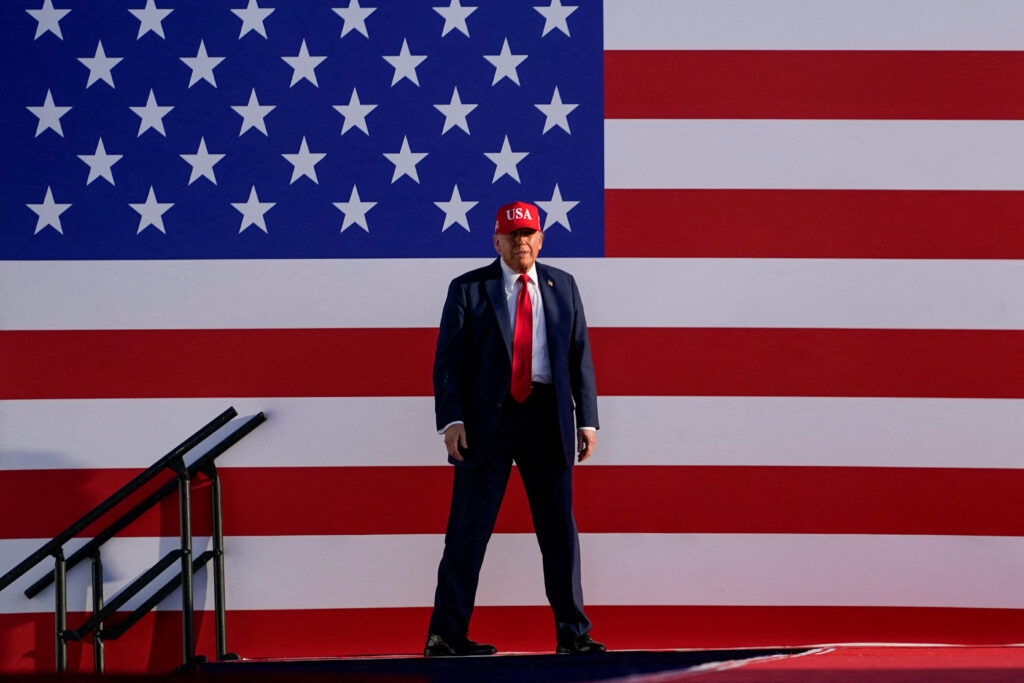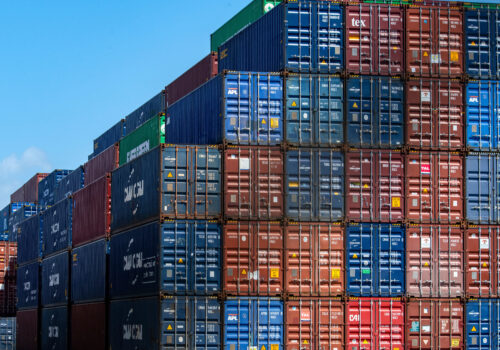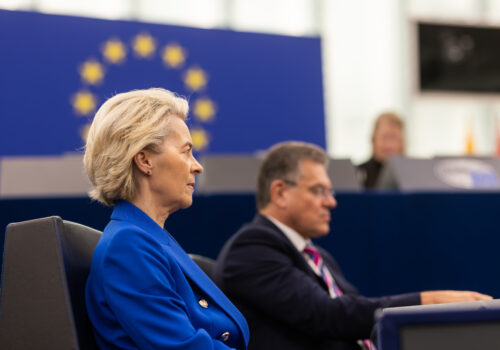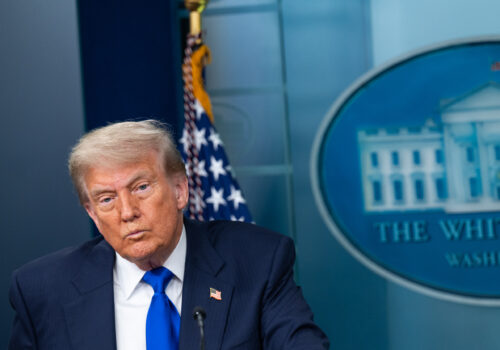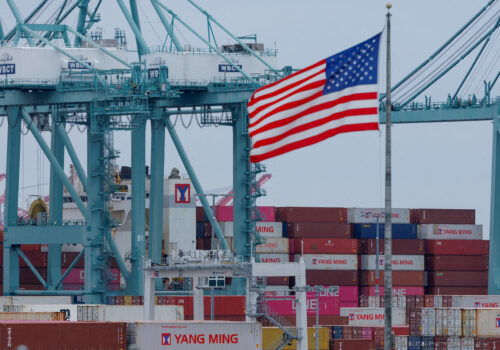Is it a punt or a two-minute drill? In April, US President Donald Trump set Wednesday, July 9, as the day that his sweeping “Liberation Day” tariffs on many countries would take effect. But on Monday he moved that date to August 1—while also sending more than a dozen letters to individual countries outlining the tariff rates their goods would face if they are unable to strike a deal. We turned to our trade experts to unpack the meaning of these moves and what to expect in the coming weeks.
Click to jump to an expert analysis:
Josh Lipsky: August 1 is a sign of seriousness—not a punt
Barbara Matthews: Trump’s asymmetric negotiations might be working
Mark Linscott: Trump needs to close the deal with India
L. Daniel Mullaney: Any breathing room for dealmaking is a welcome development
August 1 is a sign of seriousness—not a punt
As I have said since November, Trump is more serious about tariffs than the markets believe. After he announced a ninety-day pause on April 9, markets believed he was on a steady climb-down. But what Monday showed is that the ninety days were actually a true pause, and now he is doubling down on tariffs.
The markets still think he is punting, with only a small drop since the letters started going out Monday. But the August 1 deadline is actually a sign of seriousness. If Trump wanted to punt, then it would likely be another ninety-day pause, or at least a postponement until after Labor Day. Three weeks in July is basically the blink of an eye. It’s very possible we get to the other end of this and he implements many of these tariffs—though there certainly will be some deals made along the way, like we saw with the United Kingdom in May.
In the meantime, allies and adversaries alike are being targeted. Letters have gone out to countries from Japan to Myanmar, and there’s more to come. It doesn’t matter if you have a free trade agreement, as South Korea does. Trump is blowing past that. Japan was close to a deal and wanted tariffs dropped to zero for cars; instead, Tokyo is facing 25 percent across the board, which would be crippling for its auto industry (and the jobs Japanese auto companies create in the United States through their factories in Trump-voting states such as Georgia, North Carolina, Mississippi, Alabama, Ohio, and Indiana).
But the political incentives have shifted for Trump. He has already signed his major tax and domestic policy bill, so he can afford to upset members of Congress, including those representing heavily agricultural districts that may lose out with these tariffs.
It’s important to remember that even now, tariffs are at the highest level in decades at 10 percent, plus sectoral tariffs on a range of goods, such as automobiles and steel, at 25 percent or above. And there is likely more coming on pharmaceuticals in the weeks ahead. The end result is a much higher tariff environment for a longer period of time than most predicted at the start of the year. The markets still haven’t woken up to that reality.
—Josh Lipsky is the chair of international economics at the Atlantic Council and the senior director of the Atlantic Council’s GeoEconomics Center.
Trump’s asymmetric negotiations might be working
When the Trump administration initiated a reciprocal tariff structure and multiple simultaneous bilateral negotiations, the stated purpose was to address its list of grievances with the established multilateral trading system. Most analysis and media coverage thus far, understandably, has focused on the individual bilateral negotiations.
However, the bilateral parallel negotiations also create opportunities for asymmetrical bargaining. The Trump administration’s willingness to extend negotiations suggests that it might be seeing traction on some of the issues that it prioritized earlier this year. Some potential indicators of policy traction during June 2025 include:
Canadian Prime Minister Mark Carney in early June directly raised the fentanyl trade issue with Chinese Premier Li Qiang, wrangling an apparent bilateral commitment to work together “to address the fentanyl crisis.” And the Group of Seven (G7) agreed to a statement targeting state-sponsored transnational repression—a clear swipe at China.
In addition, both Japan and the European Commission are taking more direct action against Chinese overcapacity. In June, both imposed antidumping duties on Chinese graphite electrodes (Japan: 95 percent; the European Union: 74.9 percent) while the G7 under Canada’s leadership agreed to an action plan to diversify supply chains regarding critical minerals—another clear swipe at China. The G7 also characterized critical minerals as a security issue.
Markets are already adjusting to the trade war dynamics and seem to be hunkering down for a protracted period of uncertainty. Capital market volatility seems no longer to be triggered by headlines.
Six months of drama also create material incentives for companies to adjust sourcing strategies even without final trade deals. For example, sourcing strategies for aluminum are seeing substantial shifts. International Trade Administration data show that during the first half of 2025, US aluminum imports from China, Canada, Brazil, South Africa, Mexico, Malaysia, and Turkey are sharply down while imports from Argentina, Qatar, Vietnam, and India have increased sharply. US aluminum buyers during 2025 have been shifting their sourcing away from countries more oppositional to Trump and toward countries reportedly more eager for a deal.
The Trump administration may also be buying time for negotiations to proceed. The full impact of the Section 232 tariffs on the auto sector has been delayed through at least April 2027.
When policymakers dig in to play a long game, the technical details matter. The details tell us significant negotiations remain underway, those negotiations are increasingly asymmetric, and market reaction functions can amplify negotiating leverage in unconventional ways.
—Barbara C. Matthews is a nonresident senior fellow with the Atlantic Council. She is also CEO and founder of BCMstrategy, Inc and a former US Treasury attaché to the European Union.
Trump needs to close the deal with India
It would be hard to find a former US trade negotiator, including this one, who has anything good to say about this latest rollout of tariff announcements by the Trump administration. The trade policy is as clear as mud at this point. The letters, which are history-making in their use of syntax and capitalization for presidential correspondence to foreign leaders, give us no new information on progress in trade negotiations and whether there will be any new trade deals to add to the half-baked ones already announced for the United Kingdom and Vietnam.
While it is disappointing that the administration has not yet made an announcement of an interim deal with India, there has been a steady stream of reliable reports of progress in those negotiations. It appears that negotiators even concluded the details of an agreement in principle, yet the administration is holding off on an announcement. It is time to put points on the board in the US-India trade relationship. In the last Trump administration, a bilateral trade agreement between the United States and India was the one that got away. A repeat of this history would be a remarkable misuse of leverage, a precious commodity in trade negotiations.
—Mark Linscott is a nonresident senior fellow with the Atlantic Council’s South Asia Center. He was the assistant US trade representative for South and Central Asian Affairs from 2016 to 2018, and assistant US trade representative for the World Trade Organization and Multilateral Affairs from 2012 to 2016.
Any breathing room for dealmaking is a welcome development
From the beginning, it was clear that reaching agreements—even frameworks—with multiple trading partners in ninety days was an ambitious undertaking. It seems that discussions with some partners, including the European Union, were progressing constructively, if more slowly than desired. In this sense, more breathing room to reach arrangements with negotiating partners is a welcome development.
Indeed, it would have been disappointing to snap back to threatened tariffs simply because a somewhat artificial deadline had not been met. The downside, of course, is the continued uncertainty, but that is likely to remain a feature of US trade policy for the foreseeable future.
—L. Daniel Mullaney is a nonresident senior fellow with the Atlantic Council’s Europe Center and GeoEconomics Center. He previously served as assistant US trade representative for Europe and the Middle East.
Further reading
Thu, Jun 26, 2025
To retaliate, or not to retaliate, that is the question for the EU on Trump’s tariffs
New Atlanticist By Frances Burwell
Striking back at US tariffs is unlikely to help the EU achieve its goals of a more stable and open trading partnership with the United States.
Tue, Jul 1, 2025
What to expect as Trump’s tariff deadline looms
Fast Thinking By
What will the Trump administration do when the ninety-day pause on its “reciprocal” tariffs expires on July 9?
Tue, Jun 17, 2025
What should Trump do next on trade? Optimize existing US trade agreements in Central and South America.
New Atlanticist By Enrique Millán-Mejía
The best way to foster sustainable growth for US exports to the region is to seek predictable rules of engagement with Western Hemisphere trading partners.
Image: US President Donald Trump looks on as he attends an event hosted by America250, in Des Moines, Iowa, U.S., July 3, 2025. REUTERS/Nathan Howard
